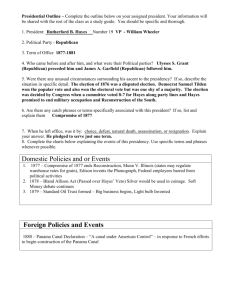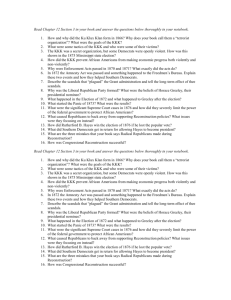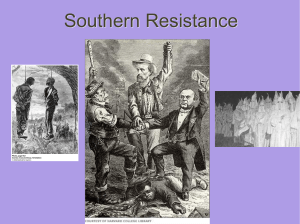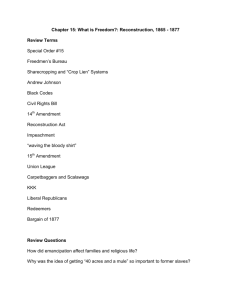The End of Reconstruction
advertisement
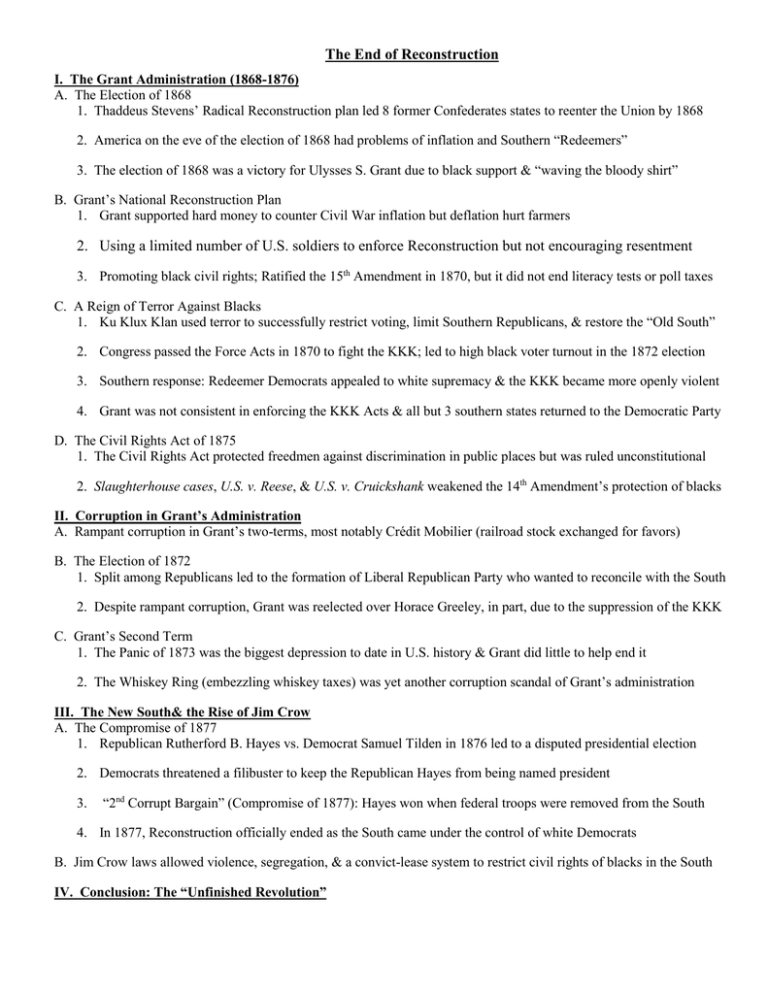
The End of Reconstruction I. The Grant Administration (1868-1876) A. The Election of 1868 1. Thaddeus Stevens’ Radical Reconstruction plan led 8 former Confederates states to reenter the Union by 1868 2. America on the eve of the election of 1868 had problems of inflation and Southern “Redeemers” 3. The election of 1868 was a victory for Ulysses S. Grant due to black support & “waving the bloody shirt” B. Grant’s National Reconstruction Plan 1. Grant supported hard money to counter Civil War inflation but deflation hurt farmers 2. Using a limited number of U.S. soldiers to enforce Reconstruction but not encouraging resentment 3. Promoting black civil rights; Ratified the 15th Amendment in 1870, but it did not end literacy tests or poll taxes C. A Reign of Terror Against Blacks 1. Ku Klux Klan used terror to successfully restrict voting, limit Southern Republicans, & restore the “Old South” 2. Congress passed the Force Acts in 1870 to fight the KKK; led to high black voter turnout in the 1872 election 3. Southern response: Redeemer Democrats appealed to white supremacy & the KKK became more openly violent 4. Grant was not consistent in enforcing the KKK Acts & all but 3 southern states returned to the Democratic Party D. The Civil Rights Act of 1875 1. The Civil Rights Act protected freedmen against discrimination in public places but was ruled unconstitutional 2. Slaughterhouse cases, U.S. v. Reese, & U.S. v. Cruickshank weakened the 14th Amendment’s protection of blacks II. Corruption in Grant’s Administration A. Rampant corruption in Grant’s two-terms, most notably Crédit Mobilier (railroad stock exchanged for favors) B. The Election of 1872 1. Split among Republicans led to the formation of Liberal Republican Party who wanted to reconcile with the South 2. Despite rampant corruption, Grant was reelected over Horace Greeley, in part, due to the suppression of the KKK C. Grant’s Second Term 1. The Panic of 1873 was the biggest depression to date in U.S. history & Grant did little to help end it 2. The Whiskey Ring (embezzling whiskey taxes) was yet another corruption scandal of Grant’s administration III. The New South& the Rise of Jim Crow A. The Compromise of 1877 1. Republican Rutherford B. Hayes vs. Democrat Samuel Tilden in 1876 led to a disputed presidential election 2. Democrats threatened a filibuster to keep the Republican Hayes from being named president 3. “2nd Corrupt Bargain” (Compromise of 1877): Hayes won when federal troops were removed from the South 4. In 1877, Reconstruction officially ended as the South came under the control of white Democrats B. Jim Crow laws allowed violence, segregation, & a convict-lease system to restrict civil rights of blacks in the South IV. Conclusion: The “Unfinished Revolution”
